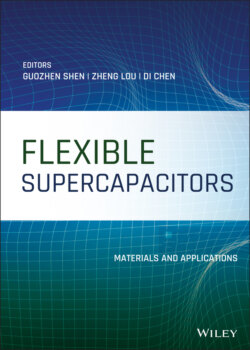Читать книгу Flexible Supercapacitors - Группа авторов - Страница 41
2.3.2 Self‐Healable SCs
ОглавлениеSelf‐healability as a remarkable function that helps SCs from complete damage and then prolong the lifespan of the energy storage has been introduced into stretchable SC systems [76]. Similarly, self‐healable SCs possess two main categories, including fiber shaped energy storage and planar SCs. 1D self‐healable SCs devices have received tremendous attention in recent years as they can be woven into textiles and fit the curved surface of the human body as well as easily integration with portable and wearable electronics. Until now, many 1D fiber shaped self‐healable SCs have been designed. For example, our group proposed a self‐healable fiber SCs by twisting two NiCo2O4 electrode covered PVA/KOH hydrogel [77]. During the damaging‐healing cycles, 82.19% of capacity was remained after four cycles, achieving the goal of the reactivated work once the devices was damaged. Zhi's group reported a twisted 1D self‐healable SCs with self‐healable PU shell [28]. In their work, magnetic Fe3O4 materials electrode were directly grown on the bare yarn via hydrothermal and annealed process, then a 2 μm thickness of polypyrrole (PPy) film was deposited on the surface of Fe3O4 nanomaterials. The schematic illustration of the self‐healing process and self‐healing mechanism were displayed in Figure 2.14a and b. It can be concluded that the excellent self‐healing properties derive from the synergistic effects between the self‐healing PU shell and the magnetic Fe3O4 electrodes. In detail, the strong intermolecular hydrogen bonds of PU shell are reversible and could reestablish when the broken components are brought into contact. Besides, the magnetic Fe3O4 electrodes can also electrically reconnected when the devices were cut into pieces. Figure 2.14c showed the CV curves of the fabricated SCs after several healing cycles. The specific capacitance of the self‐healing device obtained from the CV curve was 61.4 mF cm−2 at a scan rate of 10 mV s−1. We can see even after four cutting–healing cycles, 71.8% of the capacitance retention was observed, providing an excellent self‐healing performance. This work may encourage the design and fabrication of the 1D fiber shaped self‐healable energy storage and wearable electronics.
Self‐healable 2D planar SCs are another attractive energy storage because they possess the advantage of 2D devices like small size, low weight, ease of handing in appearance as well as the ultralong lifespan of the stretchable electronics. As a typical example, Huang et.al fabricated a 2D planar self‐healable SC based on PAA dual cross linked by hydrogen bonding and vinyl hybrid silica nanoparticles (VSNPs) [31]. Figure 2.14d illustrated the schematics of the fabrication process of the highly stretchable and self‐healable SCs. As for electrode materials, CNT papers were synthesized by CVD, and then deposited with the PPy, which were attached on the both side of the self‐healable VSNPs‐PAA gel electrolyte‐based film to prepare a self‐healable planar SCs. Figure 2.14e showed the demonstration of and ionic conductivity of the self‐healed substrate. The wound in the VSNPs‐PAA film could be autonomously repaired via the intermolecular hydrogen bonds among the cross‐linked polymer chains on the VSNPs in 10 mins under the ambient condition, which has no effect on the ionic conductivity and mechanical properties of the VSNPs‐PAA film. The CV curves with different cut‐healing times were depicted in the Figure 2.14f. The fabricated self‐healable SCs exhibited a specific capacitance of 61.4 mF cm−2 at a scan rate of 10 mV s−1, which was kept unchanged even after four healing cycles.
